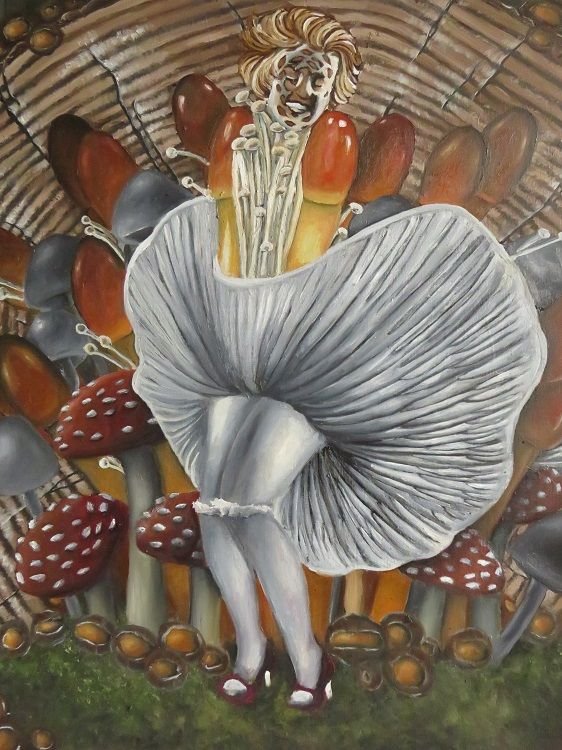
As I promised, I am going to delve a little deeper into research about the fungi I've used to put Marilyn together. I've added another one since last post, the little cups - Galiella Rufa. Without further ado.
Oudemansiella Mucida - Her dress and legs. Last post, I wrote that they are edible. They need to be washed, but they are a delicacy in some places. Scholarly articles on this fungus are as recent as this year, and as far back as at least 1973. These mushrooms have long been studied for their powerful antifungal(seems ironic, however they produce a powerful fungicide that deters or even annihilates called strobilurins) and antibacterial properties. It seems that one medicine was produced back in the seventies - Mucidin - on which there are scholarly articles, but I can't find too many layman language reports on it, which makes me think it never made it past testing, or perhaps is called something else now. That scientific researchers still find promise is reassuring, as there is much for us humans to learn in healthcare. As for the edibles, they are not commonly eaten because the mucosal coating is off-putting, and the flesh tends to be insubastantial except in very large mushrooms, but that it is almost as delicious as an oyster mushroom.
Enoki Mushrooms - Her torso. A very recent study (2018) of flammulina valutipes (enoki mushrooms) has indicated that a polysaccaride (sugar) compound in the mushroom have notably improved the learning and memory functions in mice, due to its regulative effects on the gut microbiome (intestinal bacteria) having an effect on neuroinflammation (brain swelling). http://pubs.rsc.org/en/content/articlelanding/2018/fo/c7fo01991b/unauth#!divAbstract
A TED talk I watched recently on mycology by Paul Stammets (I believe) insinuated also that the region wherein Enokis are grown is less afflicted by some cancers than other regions. I can't find the specific research on this, but here's hoping. Elsewise, Enokis are a great addition to a variety of dishes. They are commonly used as a garnish for soups and salads, being slightly crunchy.
Amanita Caesarea - Her arms. Researchers are still measuring potential positive effects this mushroom, which is apparently very rich in antioxidants. Researchers are especially interested in the potential neuroprotective qualities it may have against the effects of diseases such as Alzheimers. http://www.mdpi.com/1422-0067/18/8/1623/htm This article indicates that while much more research needs to be done in this field before there can be any conclusion, they remain optimistic via the effects they've been able to record from mice.
I wouldn't recommend hunting for these on your own unless you're an expert or with one, since they're sometimes mistaken with related amanitas that are deadly, but if you do get your hands on some, here's a recipe! https://italiannotes.com/pasta-with-caesar-mushrooms/
Schizophyllum Commune - Her hair. http://www.papersearch.net/thesis/article.asp?key=3525874 This study has determined a decidedly positive antibacterial aspect to compounds taken from this mushroom. In Thailand, these mushrooms are used in a variety of recipes. They're called Kanglayens, or split-gill mushrooms. Here's a Youtube video!
Bunashimeji - Her face. https://www.sciencedirect.com/science/article/pii/S0308814613004706 This study indicates there is much pre-existing research on the anti-leukemia properties found in this mushroom, that now they are working to isolate those properties. These mushrooms are a common food item, too! Here's a recipe! https://www.thespruce.com/sauteed-clamshell-mushroom-recipe-101864
Amanita Muscaria - Her shoes. https://psychonautwiki.org/w/index.php?title=Amanita_muscaria&_= This mushroom is probably the one that's easiest to look up yourself! It's hallucinogenic, so it's verrrrrrrrrrry popular. By that stretch, yes, it's edible, but you're unlikely to find any fancy pasta recipes that call for it.
Galiella Rufa - The border. https://lup.lub.lu.se/search/publication/8228727 Other articles have indicated research of protection against liver damaging fibroid growths. This article indicates promise of this mushroom potentially as a treatment for especially deadly otherwise unresponsive prostate cancer for men. These mushrooms are considered inedible in most places, but are apparently commonly eaten in Malaysia. I can't find any recipes for this one. Oh well!
I want to make an important note here, as someone who has lost someone to cancer, I am personally infuriated when I see people touting 'miracle cures' made of lemon, or that absolute horseshit about cancer not surviving in an alkaline environment. None of the above mushrooms can be expected to prevent, or cure your ailments by means of eating them alone. These are only studies, hopeful research, and more than likely, the anti-cancer compounds found are part and parcel to chemotherapy developments, not dietary cures.
Eat what makes you happy. Do your own research when you want to learn. Learning is fun.
Lumina.parry@hotmail.co.uk for purchase inquiries and commissions.
Facebook - https://www.facebook.com/RachelSVParry/
Twitter - https://twitter.com/RachelSVParry
Instagram - https://www.instagram.com/rachelsvparry/
Fungi are incredibly interesting organisms, have you read up on the "leather" they're making from Fungi.
www.designindaba.com/articles/creative-work/mushroom-leather-future-fungal
This is a young South African ceramic students work based on Fungi, I thought you may find it interesting. Her name is Marilise Snyman

They are! I've been gorging on fungi info the past month or so, and I feel like I know nothing. I watched a demo about the fungi leather recently. Faster and more environmentally efficient than cow leather by far. It's so fascinating. :D
I'll have to check her out sometime. Thank you!
Wow...this is a excellent and beautiful art photography...thanks my friend
WOW' thats a great art or painting.thanks for gift me this post.love you always.
This one is just wonderful